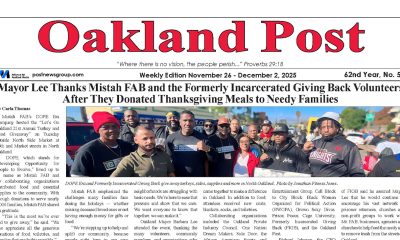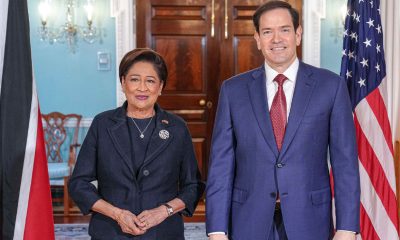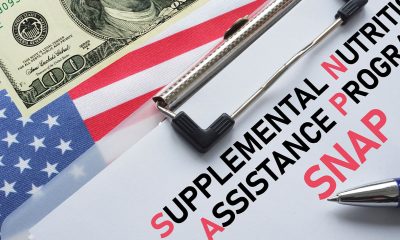Business
African American Chefs Break the Glass Ceiling in the Culinary World
NNPA NEWSWIRE — Many African American chefs often get stuck in the kitchen as sous chefs or line chefs and routinely don’t receive an opportunity to become head chefs, according to FSR. And, African American chefs, on the whole, have encountered tougher obstacles raising funds to open their own establishments.
By Stacy M. Brown, NNPA Newswire Correspondent
@StacyBrownMedia
The culinary business world is as cut throat as any other. It’s also known as an industry that hasn’t always allowed for much diversity in management and ownership at its higher echelon.
However, it appears that African Americans are finally breaking barriers, starring in many kitchens around the nation and serving up fine delicacies and treats that have those of all races and backgrounds coming back for second-helpings.
“Memphis is a foodie town with a minority-majority makeup… thoughtful discussions about equity in the food industry are at the forefront here and folks care about presentation, which is at the heart of the issue,” said Cynthia Daniels, the founder of Memphis Black Restaurant Week. “I’ve also seen the difficulty that black-owned restaurants experience with not having big marketing budgets to advertise for new business,” Daniels said.
That’s why she founded Memphis Black Restaurant Week and have advised other cities to do the same.
“It’s a celebration that advocates for black chefs, brings more awareness around their food and beverage traditions, generates new income, and moves the needle in terms of inclusivity in the culinary world,” Daniels said.
That inclusion and enthusiasm appears to have caught on.
“I am truly optimistic for the future with the culinary industry because while there are still a lot of areas in which to grow, we are slowly chipping away the stereotype of what African American chefs have to offer,” said award-winning executive chef and QVC Food Stylist Kristol Bryant.
“We are diversified in our skills, talents and cuisines. African American chefs are no longer just soul-food or southern cuisine chefs, we are so much more,” Bryant said.
“Through education and exploration, we can finally break into areas that we never knew were there. Being seen on television is great for us but being a legitimate authority in culinary in the corporate, private and entertainment sectors is the next step.”
An article in the culinary-centric publication, FSR Magazine, noted that when its reporters wrote about the rise of African American chefs in the U.S. three years ago, several themes prevailed, including that a wide range of talented African American chefs had emerged, like Executive Chef Edouardo Jordan in Seattle, Marcus Samuelsson in New York, and Mashama Bailey in Savannah, Ga.
Often, African American chefs are stuck in the kitchen as sous chefs or line chefs and routinely failing to be given an opportunity to become head chefs, according to FSR. And, African American chefs, on the whole, have encountered tougher obstacles raising funds to open their own establishments.
However, the industry now has several African American chefs serving as role models and paving the way for more minority chefs to make their mark in the U.S.
Examples include Chef Dieuveil Malonga, a 26-year old Forbes 30 under 30 Congolese Chef and a finalist for the Basque Culinary World Prize. Malonga works closely with luxury and fashion brands such as Rick Owens to bring awareness about the African continent through exclusive culinary experiences around the world.
With private clients like ASAP Rocky, Mos Def and others, Malonga has been featured by The New York Times, Vogue, BBC. He’s also spoken at The United Nations World Tourism Organization.
Chef Ronnie Rainwater of Delmonico Steakhouses also serves as another example of African Americans breaking the proverbial glass ceiling in the culinary world.
“He grew up in the kitchen, shadowing his Southern grandmother at the stove; anxious to taste anything he could get his hands on,” said Sade Mills of One 7 Communications.
Rainwater attended Western Culinary Institute in Portland, Oregon and obtained a Culinary Arts Degree in 1999. One of his early jobs in the industry was an internship in the kitchen at The Playboy Mansion in Beverly Hills, where he helped prepare dinners and private events for guests.
In June 1999, Ronnie was offered a position as a cook at Emeril Lagasse’s Delmonico Steakhouse at The Venetian and moved to Las Vegas.
In 2007, he was promoted to executive sous chef at the restaurant.
In January 2011, after working with Emeril for over 11 years at his restaurants in Las Vegas and on the East coast, he was tapped to become the next chef de cuisine of Delmonico Steakhouse.
“Today, he leads the kitchen at Delmonico and oversees all facets of its culinary operations, from sourcing products, to managing the restaurant’s in-house dry-aging program for prime U.S.D.A. beef, to crafting ambitious nightly tasting menus for guests at his kitchen table,” Mills said.
“His love of simple fresh ingredients has helped him cultivate close relationships with local farmers who supply the restaurant with their best products including beets, heirloom tomatoes, squash blossoms and seasonal herbs,” she said, noting that a local orchard provides him with fresh apples and cider, along with the apple wood used to brine and smoke the restaurant’s house cured bacon.
The rise of the African American chef also was seen at the 2018 James Beard Awards, where four African American and Caribbean American chefs were honored at the ceremony.
“There is a black hand in many pots and today, talented chefs are using their culinary skill-set as platforms to create, motivate and inspire,” said Charla Draper, a former food editor at Ebony and Southern Living magazines, who now serves as a consultant providing marketing services for food and food-related business.
“Chefs are using their talents traditionally and non-traditionally to mentor and open doors for others,” she said.
Activism
Oakland Post: Week of December 24 – 30, 2025
The printed Weekly Edition of the Oakland Post: Week of – December 24 – 30, 2025

To enlarge your view of this issue, use the slider, magnifying glass icon or full page icon in the lower right corner of the browser window.
Activism
Lu Lu’s House is Not Just Toying Around with the Community
Wilson and Lambert will be partnering with Mayor Barbara Lee on a toy giveaway on Dec. 20. Young people, like Dremont Wilkes, age 15, will help give away toys and encourage young people to stay in school and out of trouble. Wilkes wants to go to college and become a specialist in financial aid. Sports agent Aaron Goodwin has committed to giving all eight young people from Lu Lu’s House a fully paid free ride to college, provided they keep a 3.0 grade point average and continue the program. Lu Lu’s House is not toying around.

Special to the Post
Lu Lu’s House is a 501c3 organization based in Oakland, founded by Mr. Zirl Wilson and Mr. Tracy Lambert, both previously incarcerated. After their release from jail, they wanted to change things for the better in the community — and wow, have they done that!
The duo developed housing for previously incarcerated people, calling it “Lu Lu’s House,” after Wilson’s wonderful wife. At a time when many young people were robbing, looting, and involved in shootings, Wilson and Lambert took it upon themselves to risk their lives to engage young gang members and teach them about nonviolence, safety, cleanliness, business, education, and the importance of health and longevity.
Lambert sold hats and T-shirts at the Eastmont Mall and was visited by his friend Wilson. At the mall, they witnessed gangs of young people running into the stores, stealing whatever they could get their hands on and then rushing out. Wilson tried to stop them after numerous robberies and finally called the police, who Wilson said, “did not respond.” Having been incarcerated previously, they realized that if the young people were allowed to continue to rob the stores, they could receive multiple criminal counts, which would take their case from misdemeanors to felonies, resulting in incarceration.

Lu Lu’s House traveled to Los Angeles and obtained more than 500 toys
for a Dec. 20 giveaway in partnership with Oakland Mayor Barbara
Lee. Courtesy Oakland Private Industry,
Wilson took it upon himself to follow the young people home and when he arrived at their subsidized homes, he realized the importance of trying to save the young people from violence, drug addiction, lack of self-worth, and incarceration — as well as their families from losing subsidized housing. Lambert and Wilson explained to the young men and women, ages 13-17, that there were positive options which might allow them to make money legally and stay out of jail. Wilson and Lambert decided to teach them how to wash cars and they opened a car wash in East Oakland. Oakland’s Initiative, “Keep the town clean,” involved the young people from Lu Lu’s House participating in more than eight cleanup sessions throughout Oakland. To assist with their infrastructure, Lu Lu’s House has partnered with Oakland’s Private Industry Council.
For the Christmas season, Lu Lu’s House and reformed young people (who were previously robbed) will continue to give back.
Lu Lu’s House traveled to Los Angeles and obtained more than 500 toys.
Wilson and Lambert will be partnering with Mayor Barbara Lee on a toy giveaway on Dec. 20. Young people, like Dremont Wilkes, age 15, will help give away toys and encourage young people to stay in school and out of trouble. Wilkes wants to go to college and become a specialist in financial aid. Sports agent Aaron Goodwin has committed to giving all eight young people from Lu Lu’s House a fully paid free ride to college, provided they keep a 3.0 grade point average and continue the program. Lu Lu’s House is not toying around.
Activism
Desmond Gumbs — Visionary Founder, Mentor, and Builder of Opportunity
Gumbs’ coaching and leadership journey spans from Bishop O’Dowd High School, Oakland High School, Stellar Prep High School. Over the decades, hundreds of his students have gone on to college, earning academic and athletic scholarships and developing life skills that extend well beyond sports.

Special to the Post
For more than 25 years, Desmond Gumbs has been a cornerstone of Bay Area education and athletics — not simply as a coach, but as a mentor, founder, and architect of opportunity. While recent media narratives have focused narrowly on challenges, they fail to capture the far more important truth: Gumbs’ life’s work has been dedicated to building pathways to college, character, and long-term success for hundreds of young people.
A Career Defined by Impact
Gumbs’ coaching and leadership journey spans from Bishop O’Dowd High School, Oakland High School, Stellar Prep High School. Over the decades, hundreds of his students have gone on to college, earning academic and athletic scholarships and developing life skills that extend well beyond sports.
One of his most enduring contributions is his role as founder of Stellar Prep High School, a non-traditional, mission-driven institution created to serve students who needed additional structure, belief, and opportunity. Through Stellar Prep numerous students have advanced to college — many with scholarships — demonstrating Gumbs’ deep commitment to education as the foundation for athletic and personal success.

NCAA football history was made this year when Head Coach from
Mississippi Valley State, Terrell Buckley and Head Coach Desmond
Gumbs both had starting kickers that were women. This picture was
taken after the game.
A Personal Testament to the Mission: Addison Gumbs
Perhaps no example better reflects Desmond Gumbs’ philosophy than the journey of his son, Addison Gumbs. Addison became an Army All-American, one of the highest honors in high school football — and notably, the last Army All-Americans produced by the Bay Area, alongside Najee Harris.
Both young men went on to compete at the highest levels of college football — Addison Gumbs at the University of Oklahoma, and Najee Harris at the University of Alabama — representing the Bay Area on a national level.
Building Lincoln University Athletics From the Ground Up
In 2021, Gumbs accepted one of the most difficult challenges in college athletics: launching an entire athletics department at Lincoln University in Oakland from scratch. With no established infrastructure, limited facilities, and eventually the loss of key financial aid resources, he nonetheless built opportunities where none existed.
Under his leadership, Lincoln University introduced:
- Football
- Men’s and Women’s Basketball
- Men’s and Women’s Soccer
Operating as an independent program with no capital and no conference safety net, Gumbs was forced to innovate — finding ways to sustain teams, schedule competition, and keep student-athletes enrolled and progressing toward degrees. The work was never about comfort; it was about access.
Voices That Reflect His Impact
Desmond Gumbs’ philosophy has been consistently reflected in his own published words:
- “if you have an idea, you’re 75% there the remaining 25% is actually doing it.”
- “This generation doesn’t respect the title — they respect the person.”
- “Greatness is a habit, not a moment.”
Former players and community members have echoed similar sentiments in public commentary, crediting Gumbs with teaching them leadership, accountability, confidence, and belief in themselves — lessons that outlast any single season.
Context Matters More Than Headlines
Recent articles critical of Lincoln University athletics focus on logistical and financial hardships while ignoring the reality of building a new program with limited resources in one of the most expensive regions in the country. Such narratives are ultimately harmful and incomplete, failing to recognize the courage it takes to create opportunity instead of walking away when conditions are difficult.
The real story is not about early struggles — it is about vision, resilience, and service.
A Legacy That Endures
From founding Stellar PREP High School, to sending hundreds of students to college, to producing elite athletes like Addison Gumbs, to launching Lincoln University athletics, Desmond Gumbs’ legacy is one of belief in young people and relentless commitment to opportunity.
His work cannot be reduced to headlines or records. It lives on in degrees earned, scholarships secured, leaders developed, and futures changed — across the Bay Area and beyond.
-

 #NNPA BlackPress3 weeks ago
#NNPA BlackPress3 weeks agoLIHEAP Funds Released After Weeks of Delay as States and the District Rush to Protect Households from the Cold
-

 Alameda County3 weeks ago
Alameda County3 weeks agoSeth Curry Makes Impressive Debut with the Golden State Warriors
-

 Activism4 weeks ago
Activism4 weeks agoOakland Post: Week of November 26 – December 2, 2025
-

 #NNPA BlackPress3 weeks ago
#NNPA BlackPress3 weeks agoSeven Steps to Help Your Child Build Meaningful Connections
-

 #NNPA BlackPress3 weeks ago
#NNPA BlackPress3 weeks agoSeven Steps to Help Your Child Build Meaningful Connections
-

 #NNPA BlackPress4 weeks ago
#NNPA BlackPress4 weeks agoTrinidad and Tobago – Prime Minister Confirms U.S. Marines Working on Tobago Radar System
-

 #NNPA BlackPress4 weeks ago
#NNPA BlackPress4 weeks agoThanksgiving Celebrated Across the Tri-State
-

 #NNPA BlackPress4 weeks ago
#NNPA BlackPress4 weeks agoTeens Reject Today’s News as Trump Intensifies His Assault on the Press
























































4 Comments